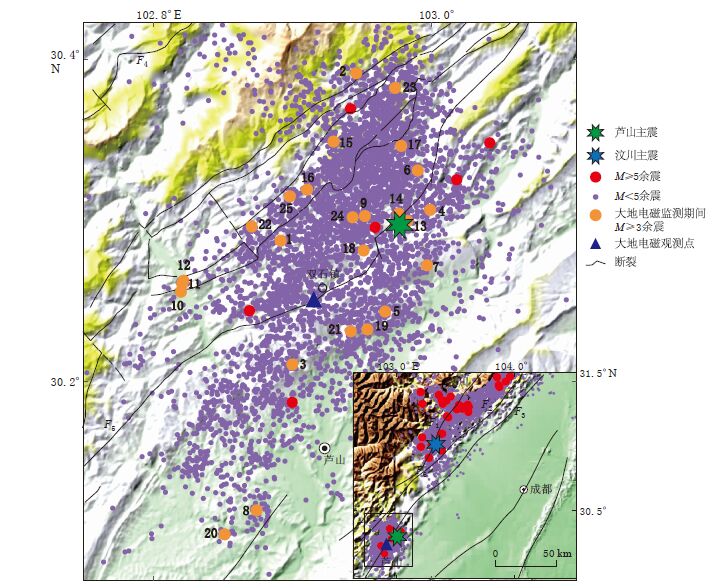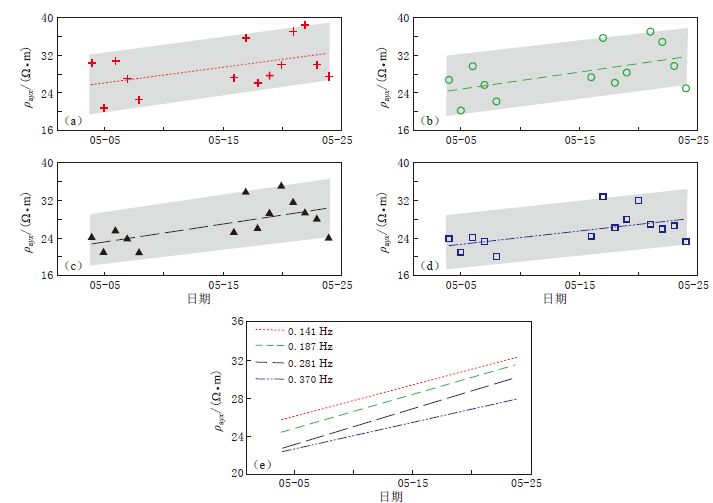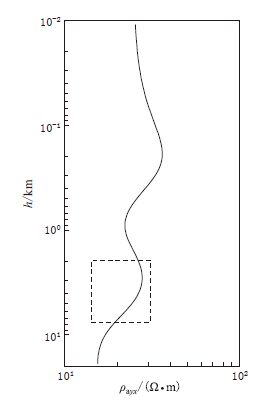Variation of magnetotelluric apparent resistivity during the major aftershock period of Lushan earthquake in epicentral area
-
摘要: 以2013年4月20日芦山MS7.0地震震后5月3—24日距主震震中约7 km处所观测到的大地电磁数据为基础, 分析地下电阻率变化与较大余震(MS>3.0)活动的关系. 为确保用于地震异常分析的观测数据的可靠性, 基于大地电磁方法的特点, 使用稳定估算(robust)技术和相干度因子约束等方法得到各频点一定数量的自功率谱和互功率谱, 再根据视电阻率和相位曲线的分布形态, 剔除引起视电阻率和相位曲线突变的谱值之后得到高质量的视电阻率和相位曲线. 此外, 根据曲线形态和误差分布来判断数据质量, 剔除可能受到干扰影响的数据, 以获得能够真实地反映地下电阻率变化的视电阻率分析结果. 结果显示: 观测期内的yx极化模式的视电阻率值总体呈非单调的增大趋势, 最大增幅达27%; yx极化模式的视电阻率值几乎在每个相对集中的较大余震丛集后均会出现高值, 而较大余震丛集期间对应的则是视电阻率低值. 从物理机制上分析地震的电阻率效应源于微裂隙内孔隙流体的变化, 故推测芦山地震余震期间电阻率的增加趋势是由于震后应变释放区应力恢复和孔隙度恢复所致.Abstract: The present paper analyzes the relationship between the apparent resistivity change and major aftershock activities based on magnetotelluric measurements data from May 3 to 24, 2013. A group of self-power and cross-power spectra are obtained with the robust method and coherence limit based on characteristics of magnetotelluric method. Then the spectra causing apparent resistivity and phase curve unsmooth are removed according to their shape, and the high-quality data are obtained after removing disturbed data. The results show that the apparent resistivity tended to increase gradually with maximum change by 27% during the measurement period but not in a monotonous manner. The yx polarized apparent resistivity ρayx reached its maximum after nearly every main aftershock cluster, but among each clusters the minimum resistivity appeared. Finally the analyses on earthquake generating mechanisms indicate that the earthquake resistivity effect is due to the change in pore fluid in micro fractures, therefore it is speculated that the increase trend of the resistivity during the period of Lushan aftershocks is caused by stress recovery and porosity recovery after the Lushan earthquake.
-
致谢: 野外工作得到了四川省地震局、 雅安防震减灾局、 芦山县防震减灾局以及江汉石油管理局地球物理勘探公司的大力支持,作者在此一并表示衷心的感谢.
-
图 1 芦山地震区域构造图及余震分布图(主震和余震分布房立华等,2013)
右下角附图为研究区的区域构造位置; 数字为较大余震的发生顺序. F1: 汶川—茂县断裂; F2: 北川 断裂; F3: 彭灌断裂; F4: 五龙断裂(北川断裂南段); F5: 双石—大川断裂(彭灌断裂南段)
Figure 1. Tectonic settings,location of mainshock and distribution of aftershocks of the 2013 Lushan MS7.0 earthquake(after Fang et al,2013)
The lower-right corner shows the position of the studied area in this paper; numbers represent the order of occurrence of large aftershocks; black triangle denotes magnetotelluric(MT)site; blue star represents Wenchuan main shock; green star represents Lushan main shock; red dots represent M≥5 aftershocks; purple dots represent M<5 aftershock; orange dots represent M≥3 aftershocks during MT measurement period. F1: Wenchuan-Maoxian fault; F2: Beichuan fault; F3: Pengguan fault; F4: Wulong fault(the south segment of Beichuan fault); F5: Shuangshi-Dachuan fault(the south segment of Pengguan fault)
图 2 观测点19天的视电阻率ρa(a)和相位Φ(b)曲线
左、 右图分别为xy极化(NS向电场)和yx极化(EW向电场)模式. 灰线为被剔除的5天数据; 黑线为用于异常分析的数据; 方框为f=0.560—0.094 Hz所对应的数据
Figure 2. The stacked curves of apparent resistivity ρa(a)and phase Φ(b)at the MT site for 19 days
The left and right panels show xy polarization(electric field in NS direction)and yx polarization(electric field in EW direction)mode,respectively. The grey curves represent the discarded data for five days,black curves represent the data used for anomaly analyses,the frame represents the data in the frequency range of 0.560—0.094 Hz
表 1 有效的观测时间记录
Table 1 Observation time records of the data used
标记日期 起始时间(UTC) 结束时间(UTC) 时长/d 年-月-日 时:分:秒 年-月-日 时:分:秒 2013-05-04 2013-05-03 09:29:49 2013-05-04 09:07:59 0.98 2013-05-05 2013-05-04 09:22:49 2013-05-05 08:00:00 0.94 2013-05-06 2013-05-05 08:00:00 2013-05-06 08:47:32 1.03 2013-05-07 2013-05-06 09:02:49 2013-05-07 08:00:00 0.96 2013-05-08 2013-05-07 08:00:00 2013-05-08 01:09:24 0.71 2013-05-16 2013-05-15 07:14:49 2013-05-16 08:00:00 1.03 2013-05-17 2013-05-16 08:00:00 2013-05-17 08:00:00 1.00 2013-05-18 2013-05-17 08:00:00 2013-05-18 08:00:00 1.00 2013-05-19 2013-05-18 08:00:00 2013-05-19 08:00:00 1.00 2013-05-20 2013-05-19 08:00:00 2013-05-20 08:00:00 1.00 2013-05-21 2013-05-20 08:00:00 2013-05-21 08:00:00 1.00 2013-05-22 2013-05-21 08:00:00 2013-05-22 08:00:00 1.00 2013-05-23 2013-05-22 08:00:00 2013-05-23 08:00:00 1.00 2013-05-24 2013-05-23 08:00:00 2013-05-24 04:07:31 0.84 表 2 变化趋势线两端相对差以及视电阻率观测误差均值
Table 2 Relative differences of apparent resistivity between two ends of trend line as well as the average errors of apparent resistivity observations
f/Hz 两端相对差 误差均值 0.141 21.54% 4.79% 0.187 24.52% 4.93% 0.281 27.03% 3.66% 0.370 21.03% 2.57% -
柏江玲, 李雪浩, 钟李彬, 徐文海, 林建, 赵乃千. 2016. 成都台地电阻率动态特征及邻区强震映震分析[J]. 防灾减灾学报, 32(1): 91-95. http://www.cnki.com.cn/Article/CJFDTOTAL-DDYJ201601017.htm Bai J L, Li X H, Zhong L B, Xu W H, Lin J, Zhao N Q. 2016. Dynamic characteristics of earth resistivity at Chengdu station and analysis on reflect of earthquake in the adjacent regions[J]. Journal of Disaster Prevention and Reduction, 32(1): 91-95 (in Chinese). http://en.cnki.com.cn/Article_en/CJFDTotal-DDYJ201601017.htm
陈军营, 刘君, 刘宝勤, 范莹莹, 崔腾飞. 2015. 2013年岷县漳县MS6.6地震前大地电磁视电阻率变化[J]. 地震, 35(4): 109-118. http://www.cnki.com.cn/Article/CJFDTOTAL-DIZN201504012.htm Chen J Y, Liu J, Liu B Q, Fan Y Y, Cui T F. 2015. Magnetotelluric apparent resistivity changes before the 2013 Minxian-Zhangxian MS6.6 earthquake[J]. Earthquake, 35(4): 109-118 (in Chinese). http://www.cnki.com.cn/Article/CJFDTOTAL-DIZN201504012.htm
陈立春, 冉勇康, 王虎, 李彦宝, 马兴全. 2013. 芦山地震与龙门山断裂带南段活动性[J]. 科学通报, 58(20): 1925-1932. http://www.cnki.com.cn/Article/CJFDTOTAL-KXTB201320007.htm Chen L C, Ran Y K, Wang H, Li Y B, Ma X Q. 2013. The Lushan MS7.0 earthquake and activity of the southern segment of the Longmenshan fault zone[J]. Chinese Science Bulletin, 58(28): 3475-3482. http://www.cnki.com.cn/Article/CJFDTOTAL-KXTB201320007.htm
陈小斌. 2003. 大地电磁正反演新算法研究及资料处理与解释的可视化集成系统开发[D]. 北京: 中国地震局地质研究所: 50-82. Chen X B. 2003. New Forward and Inversion Algorithms and a Visual Integrated System for MT Data[D]. Beijing: Institute of Geology, China Earthquake Administration: 50-82 (in Chinese).
陈小斌, 赵国泽, 汤吉, 詹艳, 王继军. 2005. 大地电磁自适应正则化反演算法[J]. 地球物理学报, 48(4): 937-946. http://www.cnki.com.cn/Article/CJFDTOTAL-DQWX200504028.htm Chen X B, Zhao G Z, Tang J, Zhan Y, Wang J J. 2005. An adaptive regularized inversion algorithm for magnetotelluric data[J]. Chinese Journal of Geophysics, 48(4): 937-946 (in Chinese). http://cn.bing.com/academic/profile?id=0ee2c6f7d366c8b8e9eb92c5671788cd&encoded=0&v=paper_preview&mkt=zh-cn
陈雪梅, 武银, 张璇, 田洁, 杨兴悦, 缑亚江. 2013. 岷县6.6级及芦山7.0级地震前天水地电阻率井下观测资料异常[J]. 地震工程学报, 35(4): 816-818. http://www.cnki.com.cn/Article/CJFDTOTAL-ZBDZ201304015.htm Chen X M, Wu Y, Zhang X, Tian J, Yang X Y, Gou Y J. 2013. The anomalies of earth resistivity recorded by the deep well observing system of Tianshui station before Minxian M6.6 earthquake and Lushan M7.0 earthquake[J]. China Earthquake Engineering Journal, 35(4): 816-818 (in Chinese). http://en.cnki.com.cn/Article_en/CJFDTotal-ZBDZ201304015.htm
陈彦平, 王燕, 洪旭瑜, 张磊, 漆银录, 张世明. 2016. 汶川MS8.0级和芦山MS7.0级地震与通渭地电阻率异常关系研究[J]. 高原地震, 28(2): 7-11. http://www.cnki.com.cn/Article/CJFDTOTAL-GYDZ201602002.htm Chen Y P, Wang Y, Hong X Y, Zhang L, Qi Y L, Zhang S M. 2016. Study on the relationship between the resistivity anomalies in Tongwei seismic station and earthquakes of Wenchuan MS8.0 and Lushan MS7.0[J]. Plateau Earthquake Research, 28(2): 7-11 (in Chinese). http://www.cnki.com.cn/Article/CJFDTOTAL-GYDZ201602002.htm
杜学彬. 2010. 在地震预报中的两类视电阻率变化[J]. 中国科学: 地球科学, 40(10): 1321-1330. http://www.cnki.com.cn/Article/CJFDTOTAL-JDXK201010004.htm Du X B. 2011. Two types of changes in apparent resistivity in earthquake prediction[J]. Science China Earth Sciences, 54(1): 145-156. doi: 10.1007/s11430-010-4031-y
杜学彬, 刘君, 崔腾发, 范莹莹, 安张辉, 闫睿, 王丽. 2015. 两次近距离大震前成都台视电阻率重现性、 相似性和各向异性变化[J]. 地球物理学报, 58(2): 576-588. http://www.cnki.com.cn/Article/CJFDTOTAL-DQWX201502020.htm Du X B, Liu J, Cui T F, Fan Y Y, An Z H, Yan R, Wang L. 2015. Repeatability, similarity and anisotropy changes in apparent resistivity recorded by station Chengdu at near distances before two great earthquakes[J]. Chinese Journal of Geophysics, 58(2): 576-588 (in Chinese). http://cn.bing.com/academic/profile?id=b7e4cf86602c172765ca4d5fe1ad2a35&encoded=0&v=paper_preview&mkt=zh-cn
房立华, 吴建平, 王未来, 吕作勇, 王长在, 杨婷, 蔡妍. 2013. 四川芦山MS7.0级地震及其余震序列重定位[J]. 科学通报, 58(20): 1901-1909. http://www.cnki.com.cn/Article/CJFDTOTAL-KXTB201320004.htm Fang L H, Wu J P, Wang W L, Lü Z Y, Wang C Z, Yang T, Cai Y. 2013. Relocation of the mainshock and aftershock sequences of MS7.0 Sichuan Lushan earthquake[J]. Chinese Science Bulletin, 58(28/29): 3451-3459. http://www.cnki.com.cn/Article/CJFDTOTAL-KXTB201320004.htm
国家地震局地质研究所大地电磁测深组. 1981. 北京凤河营地区的地壳电性结构及其在唐山大震前后的变化[G]//大地电磁测深. 北京: 地震出版社: 89-95. MT Group of Institute of Geology, State Seismological Bureau. 1981. Variation of crustal electric structure before and after Tangshan earthquake beneath Fengheying zone in Beijing[G]//Magnetotelluric Sounding. Beijing: Seismological Press: 89-95 (in Chinese).
国家地震局兰州地震研究所大地电磁测深组. 1981. 我国南北地震带北段地壳和上地幔的电性特征[G]//大地电磁测深. 北京: 地震出版社: 68-73. MT Group of Lanzhou Institute of Seismology, State Seismological Bureau. 1981. Electrical characteristics of the upper crust mantle about the northern section of the north-south seismic belt in China[G]//Magnetotelluric Sounding. Beijing: Seismological Press: 68-73 (in Chinese).
郭自强. 1994. 地震低频电磁辐射研究[J]. 地球物理学报, 37(S1): 261-268. http://www.cnki.com.cn/Article/CJFDTOTAL-DQWX4S1.022.htm Guo Z Q. 1994. Investigation on low-frequency seismoelectromagnetic emission[J]. Acta Geophysica Sinica, 37(S1): 261-268 (in Chinese). http://cn.bing.com/academic/profile?id=3ff2b489323646ddbe7b760d2c9f6b31&encoded=0&v=paper_preview&mkt=zh-cn
郝锦绮, 黄平章, 周建国. 1993. 微破裂对岩石剩磁的影响: 对地震预报的意义[J]. 地球物理学报, 36(2): 203-211. http://www.cnki.com.cn/Article/CJFDTOTAL-DQWX199302009.htm Hao J Q, Huang P Z, Zhou J G. 1993. The effect of cracking on remnant magnetization of rocks: It’s implication to earthquake prediction[J]. Acta Geophysica Sinica, 36(2): 203-211 (in Chinese). http://cn.bing.com/academic/profile?id=c6522ff1cbe1f0f5e78aff8b9c8f1581&encoded=0&v=paper_preview&mkt=zh-cn
黄清华. 2005. 地震电磁信号传播的控制模拟实验[J]. 科学通报, 50(16): 1774-1778. http://www.cnki.com.cn/Article/CJFDTOTAL-KXTB200516016.htm Huang Q H. 2005. Controlled analogue experiments on propagation of seismic electromagnetic signals[J]. Chinese Science Bulletin, 50(17): 1957-1961. http://cn.bing.com/academic/profile?id=6aac938e3a22e56fe4d3307af3aec816&encoded=0&v=paper_preview&mkt=zh-cn
刘君, 杜学彬, 范莹莹, 安张辉, 陈军营, 谭大诚, 崔腾发, 王建军. 2013. 甘肃岷县漳县MS6.6地震前的地电阻率变化[J]. 地震工程学报, 35(4): 819-826. http://cpfd.cnki.com.cn/Article/CPFDTOTAL-DZDC201308001003.htm Liu J, Du X B, Fan Y Y, An Z H, Chen J Y, Tan D C, Cui T F, Wang J J. 2013. The geo-electrical resistivity anomaly before the Minxian-Zhangxian MS6.6 earthquake in Gansu[J]. China Earthquake Engineering Journal, 35(4): 819-826 (in Chinese). http://cpfd.cnki.com.cn/Article/CPFDTOTAL-DZDC201308001003.htm
马钦忠, 方国庆, 李伟, 周江南. 2013. 芦山MS7.0地震前的电磁异常信号[J]. 地震学报, 35(5): 717-730. http://www.dzxb.org/Magazine/Show?id=28879 Ma Q Z, Fang G Q, Li W, Zhou J N. 2013. Electromagnetic anomalies before the 2013 Lushan MS7.0 earthquake[J]. Acta Seismologica Sinica, 35(5): 717-730 (in Chinese). http://www.dzxb.org/Magazine/Show?id=28879
钱复业, 赵璧如, 钱卫, 赵健, 何世根, 张洪魁, 李世愚, 李绍坤, 严谷良, 汪成民, 孙振凯, 张东宁, 卢军, 张平, 杨国军, 孙加林, 郭纯生, 唐宇雄, 徐建明, 夏坤涛, 鞠航, 殷邦红, 黎明, 杨东生, 起卫罗, 和泰名, 关华平, 赵玉林. 2009. 汶川8.0级地震HRT波地震短临波动前兆及HRT波地震短临预测方法: 关于实现强震短临预测可能性的讨论[J]. 中国科学: 地球科学, 39(1): 11-23. http://www.cnki.com.cn/Article/CJFDTOTAL-JDXK200901002.htm Qian F Y, Zhao B R, Qian W, Zhao J, He S G, Zhang H K, Li S Y, Li S K, Yan G L, Wang C M, Sun Z K, Zhang D N, Lu J, Zhang P, Yang G J, Sun J L, Guo C S, Tang Y X, Xu J M, Xia K T, Ju H, Yin B H, Li M, Yang D S, Qi W L, He T M, Guan H P, Zhao Y L. 2009. Impending HRT wave precursors to the Wenchuan MS8.0 earthquake and methods of earthquake impending prediction by using HRT wave[J]. Science China Earth Sciences, 52(10): 1572-1584. doi: 10.1007/s11430-009-0124-x
钱家栋, 马钦忠, 李劭秾. 2013. 汶川MS8.0地震前成都台NE测线地电阻率异常的进一步研究[J]. 地震学报, 35(1): 4-17. http://www.dzxb.org/Magazine/Show?id=28812 Qian J D, Ma Q Z, Li S N. 2013. Further study on the anomalies in apparent resistivity in the NE configuration at Chengdu station associated with Wenchuan MS8.0 earthquake[J]. Acta Seismologica Sinica, 35(1): 4-17 (in Chinese). http://www.dzxb.org/Magazine/Show?id=28812
石油物探专业标准化委员会. 2015. 石油大地电磁测深法采集技术规程[S]. 北京: 石油工业出版社: 7. Standardization Committee for Petroleum Geophysical Prospecting. 2015. Technical Rule for Magnetotelluric Sounding Acquistion Method in Oil Exploration[S]. Beijing: Petroleum Industry Press: 7 (in Chinese).
汤吉, 赵国泽, 王继军, 李文军, 詹艳. 1998. 张北—尚义地震前后电阻率的变化及分析[J]. 地震地质, 20(2): 164-171. http://www.cnki.com.cn/Article/CJFDTOTAL-DZDZ802.011.htm Tang J, Zhao G Z, Wang J J, Li W J, Zhan Y. 1998. Variation and analysis of resistivity before and after the Zhangbei-Shangyi earthquake[J]. Seismology and Geology, 20(2): 164-171 (in Chinese). http://en.cnki.com.cn/Article_en/CJFDTOTAL-DZDZ802.011.htm
肖武军, 关华平. 2009. 汶川8.0级地震以及其它大震前的地电阻率异常特征[J]. 西北地震学报, 31(4): 349-354, 384. http://www.cnki.com.cn/Article/CJFDTOTAL-ZBDZ200904008.htm Xiao W J, Guan H P. 2009. Anomalous change features of resistivity before the Wenchuan M8.0 earthquake and other large earthquake in China[J]. Northwestern Seismological Journal, 31(4): 349-354, 384 (in Chinese). http://cn.bing.com/academic/profile?id=46d72ab1c9a8fc3be26f666f39a5f018&encoded=0&v=paper_preview&mkt=zh-cn
解滔, 卢军, 任越霞, 赵民渊. 2013. 2013年芦山MS7.0地震前甘孜台地电阻率变化分析[J]. 震灾防御技术, 8(4): 377-388. http://www.cnki.com.cn/Article/CJFDTOTAL-ZZFY201304005.htm Xie T, Lu J, Ren Y X, Zhao M Y. 2013. Analysis on apparent resistivity variations of Ganzi station before 2013 Lushan MS7.0 earthquake[J]. Technology for Earthquake Disaster Prevention, 8(4): 377-388 (in Chinese). http://www.cnki.com.cn/Article/CJFDTOTAL-ZZFY201304005.htm
徐锡伟, 闻学泽, 韩竹军, 陈桂华, 李传友, 郑文俊, 张世民, 任治坤, 许冲, 谭锡斌, 魏占玉, 王明明, 任俊杰, 何仲, 梁明剑. 2013. 四川芦山7.0级强震: 一次典型的盲逆断层型地震[J]. 科学通报, 58(20): 1887-1893. http://www.cnki.com.cn/Article/CJFDTOTAL-KXTB201320002.htm Xu X W, Wen X Z, Han Z J, Chen G H, Li C Y, Zheng W J, Zhang S M, Ren Z K, Xu C, Tan X B, Wei Z Y, Wang M M, Ren J J, He Z, Liang M J. 2013. Lushan MS7.0 earthquake: A blind reserve-fault event[J]. Chinese Science Bulletin, 58(28/29): 3437-3443. http://cn.bing.com/academic/profile?id=71edb853384d820d5951c5010b46e5a2&encoded=0&v=paper_preview&mkt=zh-cn
詹艳, 赵国泽, Unsworth M, 王立凤, 陈小斌, 李涛, 肖骑彬, 王继军, 汤吉, 蔡军涛, 王阎昭. 2013. 龙门山断裂带西南段4·20芦山7.0级地震区的深部结构和孕震环境[J]. 科学通报, 58(20): 1917-1924. http://www.cnki.com.cn/Article/CJFDTOTAL-KXTB201320006.htm Zhan Y, Zhao G Z, Unsworth M, Wang L F, Chen X B, Li T, Xiao Q B, Wang J J, Tang J, Cai J T, Wang Y Z. 2013. Deep structure beneath the southwestern section of the Longmenshan fault zone and seimogenetic context of the 4·20 Lushan MS7.0 earthquake[J]. Chinese Science Bulletin, 58(28/29): 3467-3474. http://cn.bing.com/academic/profile?id=2bb8d51e7d6837da56eced272fcced7a&encoded=0&v=paper_preview&mkt=zh-cn
张继红, 赵国泽, 王晋生, 唐廷梅, 齐丽杰. 2010. 2008年汶川MS8.0地震与青岛台地电阻率异常变化的关系[J]. 地震地质, 32(3): 409-416. http://www.cnki.com.cn/Article/CJFDTOTAL-DZDZ201003010.htm Zhang J H, Zhao G Z, Wang J S, Tang T M, Qi L J. 2010. Preliminary study on the relationship between the MS8.0 Wenchuan earthquake of 2008 and the anomalies of earth resistivity observed at Qingdao seismic station[J]. Seismo-logy and Geology, 32(3): 409-416 (in Chinese). http://cn.bing.com/academic/profile?id=bad386b93d13114f2fa86252672a8869&encoded=0&v=paper_preview&mkt=zh-cn
张学民, 赵国泽, 陈小斌, 马为. 2007. 国外地震电磁现象观测[J]. 地球物理学进展, 22(3): 687-694. http://www.cnki.com.cn/Article/CJFDTOTAL-DQWJ200703004.htm Zhang X M, Zhao G Z, Chen X B, Ma W. 2007. Seismo-electromagnetic observation abroad[J]. Progress in Geophy-sics, 22(3): 687-694 (in Chinese). http://cn.bing.com/academic/profile?id=2240427fea20afb65efc340876e16025&encoded=0&v=paper_preview&mkt=zh-cn
张学民, 李美, 关华平. 2009. 汶川8.0级地震前的地电阻率异常分析[J]. 地震, 29(1): 108-115. http://www.cnki.com.cn/Article/CJFDTOTAL-DIZN200901014.htm Zhang X M, Li M, Guan H P. 2009. Anomaly analysis of earth resistivity observations before the Wenchuan earthquake[J]. Earthquake, 29(1): 108-115 (in Chinese). http://cn.bing.com/academic/profile?id=3629fedff7a644d5129af98416cab2f4&encoded=0&v=paper_preview&mkt=zh-cn
张云琳, 刘晓玲, 安海静, 司玉兰, 蒋梅, 张五四. 1994. MT重复测量在地震中短期预报中的应用: 祁连山中段MT剖面监测研究[J]. 地球物理学报, 37(2): 200-210. http://www.cnki.com.cn/Article/CJFDTOTAL-DQWX402.007.htm Zhang Y L, Liu X L, An H J, Si Y L, Jiang M, Zhang W S. 1994. Application of the MT repeated measurements to the medium and short term prediction of earthquake: Monitoring and studying a profile in the middle segment of Qilian Mountain by MT[J]. Acta Geophysica Sinica, 37(2): 200-210 (in Chinese). http://cn.bing.com/academic/profile?id=a3cd95293b035577b60a4e8968e59b7b&encoded=0&v=paper_preview&mkt=zh-cn
赵国泽, 陈小斌, 蔡军涛. 2007. 电磁卫星和地震预测[J]. 地球物理学进展, 22(3): 667-673. http://www.cnki.com.cn/Article/CJFDTOTAL-DQWJ200703001.htm Zhao G Z, Chen X B, Cai J T. 2007. Electromagnetic observation by satellite and earthquake prediction[J]. Progress in Geophysics, 22(3): 667-673 (in Chinese). http://cn.bing.com/academic/profile?id=b71576b9d48932ccc9a6b5d4567b25e8&encoded=0&v=paper_preview&mkt=zh-cn
赵国泽, 王立凤, 詹艳, 汤吉, 肖骑彬, 陈小斌, 王继军, 蔡军涛, 汪晓, 杨静. 2012. 地震预测人工源极低频电磁新技术(CSELF)和第一个观测台网[J]. 地震地质, 34(4): 576-585. http://www.cnki.com.cn/Article/CJFDTOTAL-DZDZ201204007.htm Zhao G Z, Wang L F, Zhan Y, Tang J, Xiao Q B, Chen X B, Wang J J, Cai J T, Wang X, Yang J. 2012. A new electromagnetic technique for earthquake monitoring: CSELF and the first observational network[J]. Seismology and Geology, 34(4): 576-585 (in Chinese). http://cn.bing.com/academic/profile?id=8bd1e63a3bae95af0e34accb52d0a991&encoded=0&v=paper_preview&mkt=zh-cn
赵国泽, Bi Y X, 王立凤, 韩冰, 汪晓, 肖骑彬, 蔡军涛, 詹艳, 陈小斌, 汤吉, 王继军. 2015. 中国地震交变电磁场观测数据处理技术新进展[J]. 中国科学: 地球科学, 45(1): 22-33. http://www.cnki.com.cn/Article/CJFDTOTAL-JDXK201501003.htm Zhao G Z, Bi Y X, Wang L F, Han B, Wang X, Xiao Q B, Cai J T, Zhan Y, Chen X B, Tang J, Wang J J. 2015. Advances in alternating electromagnetic field data processing for earthquake monitoring in China[J]. Science China Earth Sciences, 58(2): 172-182. doi: 10.1007/s11430-014-5012-3
朱涛. 2013. 汶川MS8.0地震前区域性地电阻率异常初步研究[J]. 地震学报, 35(1): 18-25. http://www.dzxb.org/Magazine/Show?id=28813 Zhu T. 2013. Preliminary study on regional geo-resistivity anomaly before the Wenchuan MS8.0 earthquake[J]. Acta Seismologica Sinica, 35(1): 18-25 (in Chinese). http://cn.bing.com/academic/profile?id=25d1c9342451cba3d131580c197bb2ca&encoded=0&v=paper_preview&mkt=zh-cn
Beamish D. 1982. The time-dependence of electromagnetic response functions[J]. Geophys Surv, 4(4): 405-434. doi: 10.1007/BF01449109
Brace W F, Orange A S, Madden T R. 1965. The effect of pressure on the electrical resistivity of water-saturated crystalline rocks[J]. J Geophys Res, 70(22): 5669-5678. doi: 10.1029/JZ070i022p05669
Brace W F, Orange A S. 1968. Electrical resistivity changes in saturated rocks during fracture and frictional sliding[J]. J Geophys Res, 73(4): 1433-1445. doi: 10.1029/JB073i004p01433
Fitterman D V. 1979. Theory of electrokinetic magnetic anomalies in a faulted half-space[J]. J Geophys Res, 84(B11): 6031-6040. doi: 10.1029/JB084iB11p06031
Glover P W J, Ádám A. 2008. Correlation between crustal high conductivity zones and seismic activity and the role of carbon during shear deformation[J]. J Geophys Res, 113(B12): B12210. doi: 10.1029/2008JB005804
Huang Q H. 2011. Retrospective investigation of geophysical data possibly associated with the MS8.0 Wenchuan earthquake in Sichuan, China[J]. J Asian Earth Sci, 41(4/5): 421-427. http://cn.bing.com/academic/profile?id=ecb235df61eff67c6db27192e5ed7957&encoded=0&v=paper_preview&mkt=zh-cn
Jiang F, Chen X B, Zhan Y, Zhao G Z, Yang H, Zhao L Q, Qiao L, Wang L F. 2016. Shifting correlation between earthquakes and electromagnetic signals: A case study of the 2013 Minxian-Zhangxian ML6.5 (MW6.1) earthquake in Gansu, China[J]. Pure Appl Geophys, 173(1): 269-284. doi: 10.1007/s00024-015-1055-4
Mizutani H, Ishido T, Yokokura T, Ohnishi S. 1976. Electrokinetic phenomena associated with earthquakes[J]. Geophys Res Lett, 3(7): 365-368. doi: 10.1029/GL003i007p00365
Píša D, Němec F, Santolík O, Parrot M, Rycroft M. 2013. Additional attenuation of natural VLF electromagnetic waves observed by the DEMETER spacecraft resulting from preseismic activity[J]. J Geophys Res, 118(8): 5286-5295. doi: 10.1002/jgra.50469
Reddy I K, Phillips R J, Whitcomb J H, Cole D M, Taylor R A. 1976. Monitoring of time dependent electrical resistivity by magnetotelluric[J]. J Geomagn Geoelec, 28(2): 165-178. doi: 10.5636/jgg.28.165
Sadovsky M A, Nersesov I L, Nigmatullaev S K, Latynina L A, Lukk A A, Semenov A N, Simbireva I G, Ulomov V T. 1972. The processes preceding strong earthquakes in some regions of middle Asia[J]. Tectonophysics, 14(3/4): 295-307. http://cn.bing.com/academic/profile?id=433b79c8722f79e350b34e794a577282&encoded=0&v=paper_preview&mkt=zh-cn
Scholz C H, Sykes L R, Aggarwal Y P. 1973. Earthquake prediction: A physical basis[J]. Science, 181(4102): 803-810. doi: 10.1126/science.181.4102.803
Stacey F D. 1963. Seismomagnetic effect and the possibility of forecasting earthquakes[J].Nature, 200(4911): 1803-1085. http://cn.bing.com/academic/profile?id=11c362ac0a3572a4bdad0bf220f27c3c&encoded=0&v=paper_preview&mkt=zh-cn
Zhao G Z, Unsworth M J, Zhan Y, Wang L F, Chen X B, Jones A G, Tang J, Xiao Q B, Wang J J, Cai J T, Li T, Wang Y Z, Zhang J H. 2012. Crustal structure and rheology of the Longmenshan and Wenchuan MW7.9 earthquake epicentral area from magnetotelluric data[J]. Geology, 40(12): 1139-1142. doi: 10.1130/G33703.1
-
期刊类型引用(15)
1. 字承柱,张翔,张源,杨树锋. 洱源滇20井水温异常特征分析与机理研究. 华南地震. 2025(01): 59-67 .  百度学术
百度学术
2. 朱玉娟,车濛琪,方震,朱厚林,吴婉楠. 安徽省流体观测井水温测项观测效能评价与分析. 科技资讯. 2024(16): 225-228 .  百度学术
百度学术
3. 何国龙,苏维刚,买振军. 基于多方法分析门源井水位巨幅异常变化及其机理. 煤炭工程. 2023(06): 119-122 .  百度学术
百度学术
4. 郭雨帆,杜晓辉,董磊,汤兰荣,赵爱平,王甘娇. 基于张衡一号卫星监测的2021年青海玛多7.4级地震前电离层效应. 地震. 2023(02): 85-102 .  百度学术
百度学术
5. 杜利峰,钟辉宗,王涛,李焱林. 青海玉树台井水位年变特征与固定干扰分析. 地震地磁观测与研究. 2023(S1): 166-168 .  百度学术
百度学术
6. 刘磊,余怀忠,李霞,赵玉红,冯丽丽,张朋涛. 2021年以来青海3次强震前地下流体重点异常特征分析. 地震地磁观测与研究. 2023(S1): 234-236 .  百度学术
百度学术
7. 刘磊,苏维刚,李霞,赵玉红,冯丽丽,张朋涛. 2022年1月8日门源M6.9地震前青海地区逸出气氡异常特征分析. 地震工程学报. 2022(02): 380-388 .  百度学术
百度学术
8. 刘磊,高小其,苏维刚,赵玉红,李霞,冯丽丽. 2022年1月8日门源M_S6.9地震前青海地区地下流体群体异常特征. 地震学报. 2022(02): 245-249 .  本站查看
本站查看
9. 芮雪莲,杨耀,官致君,杜方,薛乔文,龙锋,杨星,杨鹏. 四川理塘毛垭51泉水温在青藏高原东南缘中强地震前的异常特征及机理分析. 地震研究. 2022(02): 318-328 .  百度学术
百度学术
10. 苏维刚,刘磊,孙玺皓. 玛多7.4级地震和门源6.9级地震前佐署地下流体异常特征分析. 地震工程学报. 2022(03): 700-706+712 .  百度学术
百度学术
11. 冯丽丽,李霞,赵玉红,张朋涛. 2022年1月8日青海门源6.9级地震短临异常跟踪分析. 中国地震. 2022(01): 12-20 .  百度学术
百度学术
12. 刘磊,苏维刚,赵玉红,李霞,冯丽丽. 2022年1月8日门源M_S 6.9地震前乐都逸出气氡异常特征分析. 地震地磁观测与研究. 2022(S1): 453-455 .  百度学术
百度学术
13. 苏维刚,孙玺皓,刘磊. 2022年德令哈M_S 5.8、M_S 6.0地震前德令哈水温异常特征. 地震地磁观测与研究. 2022(S1): 456-459 .  百度学术
百度学术
14. 董超,陈斌,袁洁浩,王振东,王粲. 2021年5月22日玛多M_S7.4地震震前岩石圈磁场变化特征分析. 地震学报. 2021(04): 453-462+533 .  本站查看
本站查看
15. 钟骏,王博,周志华,晏锐. 2021年青海玛多M_S7.4地震前地下流体异常特征分析. 中国地震. 2021(03): 574-585 .  百度学术
百度学术
其他类型引用(1)





 下载:
下载:




